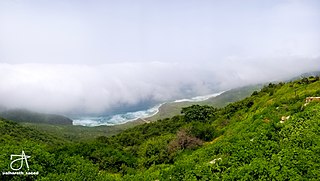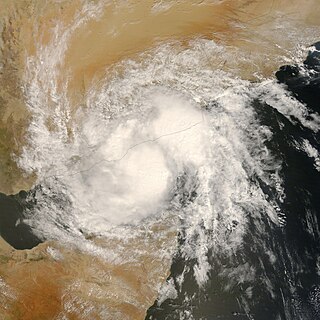
Oman is a country on the southeast coast of the Arabian Peninsula, situated in Southwest Asia, bordering the Arabian Sea, Gulf of Oman, and Persian Gulf, between Yemen and the United Arab Emirates (UAE). The coast of Oman was an important part in the Omani empire and sultanate.

A World Heritage Site is a landmark or area with legal protection by an international convention administered by the United Nations Educational, Scientific and Cultural Organization (UNESCO). World Heritage Sites are designated by UNESCO for having cultural, historical, scientific or other form of significance. The sites are judged to contain "cultural and natural heritage around the world considered to be of outstanding value to humanity".

The Arabian Peninsula, or Arabia, is a peninsula in Western Asia, situated northeast of Africa on the Arabian Plate. At 3,237,500 km2 (1,250,000 sq mi), the Arabian Peninsula is the largest peninsula in the world. It is also known as the Arabian subcontinent.

Tochigi Prefecture is a prefecture of Japan located in the Kantō region of Honshu. Tochigi Prefecture has a population of 1,943,886 and has a geographic area of 6,408 km2. Tochigi Prefecture borders Fukushima Prefecture to the north, Gunma Prefecture to the west, Saitama Prefecture to the south, and Ibaraki Prefecture to the southeast.

Western Asia, also called West Asia or Southwest Asia, is the westernmost region of Asia, as defined by some academics, UN bodies and other institutions, and includes Anatolia, the Arabian Peninsula, Iran, Mesopotamia, the Armenian Highlands, the Levant, the island of Cyprus, the Sinai Peninsula, and partly the Caucasus Region (Transcaucasia). The region is considered to be separated from Africa by the Isthmus of Suez in Egypt, and separated from Europe by the waterways of the Turkish Straits and the watershed of the Greater Caucasus. Central Asia lies to its northeast, while South Asia lies to its east. Twelve seas surround the region (clockwise): the Aegean Sea, the Sea of Marmara, the Black Sea, the Caspian Sea, the Persian Gulf, the Gulf of Oman, the Arabian Sea, the Gulf of Aden, the Red Sea, the Gulf of Aqaba, the Gulf of Suez, and the Mediterranean Sea. The area contains the vast majority of the similarly defined Middle East, except excluding the African part of Egypt, and including the southern part of the Caucasus.

Ziro is a town in and the district headquarters of the Lower Subansiri district in the Indian state of Arunachal Pradesh. It is included the Tentative List for UNESCO's World Heritage Site for the Apatani cultural landscape. The part of the town which is the centre of economic activities and where the administrative offices are located is called as Hapoli or locally known by the Apatanis as "Hao-Polyang".

Zabid is a town with an urban population of around 52,590 people on Yemen's western coastal plain. It is one of the oldest towns in Yemen, and has been a UNESCO World Heritage Site since 1993; though, in 2000, the site was placed on the List of World Heritage in Danger.

Shaki District is one of the 66 districts of Azerbaijan. It is located in the north of the country and belongs to the Shaki-Zagatala Economic Region. The district borders the districts of Qakh, Oghuz, Agdash, Yevlakh, and the Russian Republic of Dagestan. Its capital and largest city is Shaki. As of 2020, the district had a population of 188,100.

Shibam Hadramawt is a town in Yemen. With about 7,000 inhabitants, it is the seat of the District of Shibam in the Governorate of Hadhramaut. Known for its mudbrick-made high-rise buildings, it is referred to as the "Manhattan of the Desert" or "Chicago of the Desert".

Al Mahrah, or simply Mahra, is a governorate (muhafazah) of Yemen in the southern part of the Arabian Peninsula. Situated in the area of the former Mahra Sultanate, its capital is Al Ghaydah, and it has international borders with Saudi Arabia and Oman.

Raʾs al-Ḥadd is a village in Ash Sharqiyah district in Oman. It is on a point at the entrance to the Gulf of Oman.

The Slovak Karst is one of the mountain ranges of the Slovenské Rudohorie Mountains in the Carpathians in southern Slovakia. It consists of a complex of huge karst plains and plateaus. Since 1973 it has been a protected landscape area. On 1 March 2002 Slovak Karst National Park was declared. It is also a UNESCO Biosphere Reserve and part of it forms UNESCO World Heritage site Caves of Aggtelek Karst and Slovak Karst.

Bắc Trung Bộ is one of the geological regions of Vietnam. It consists of six provinces in northern part of Central Vietnam: Thanh Hóa, Nghệ An, Hà Tĩnh, Quảng Bình, Quảng Trị, Thừa Thiên–Huế. The last two provinces were the northernmost provinces of State of Vietnam and South Vietnam until 1976. In the Nguyễn dynasty, this area was known as Hữu Trực Kỳ.

The Acacus Mountains or Tadrart Akakus form a mountain range in the desert of the Ghat District in western Libya, part of the Sahara. They are situated east of the city of Ghat, Libya, and stretch north from the border with Algeria, about 100 kilometres (62 mi). The area has a particularly rich array of prehistoric rock art.

Zanzibar City or Mjini District, often simply referred to as Zanzibar is one of two administrative districts of Mjini Magharibi Region in Tanzania. The district covers an area of 15.4 km2 (5.9 sq mi). The district is comparable in size to the land area of Nauru. The district has a water border to the west by the Indian Ocean. The district is bordered to the east by Magharibi District. The district seat is located in Stonetown. The city is largest city on the island of Zanzibar. It is located on the west coast of Unguja, the main island of the Zanzibar Archipelago, north of the much larger city of Dar es Salaam across the Zanzibar Channel. The city also serves as the capital of the Zanzibar Urban/West Region. In 2012 its population was 223,033.

Deep Depression ARB 02 was a weak tropical cyclone that caused extensive damage and loss of life in Yemen in October 2008. The sixth tropical cyclone and third deep depression of the 2008 North Indian Ocean cyclone season, ARB 02 formed on October 19 off the west coast of India from the same broader system that spawned a tropical storm in the southern Indian Ocean at the same time. Moving generally westward, the depression failed to intensify much, reaching maximum sustained winds of only 55 km/h (35 mph). It was no longer classifiable as a tropical depression by October 23, and later that day, its remnants made landfall near Ash Shihr in eastern Yemen.
Traditionally, Yemen has been a tourism centre for centuries as it is in the middle of the trade routes of the Middle East and the Horn of Africa. Tourism played a fundamental role in the region in global trade and has remained so until the 20th century. Afterwards, there has been a sharp decline in tourism since the 2011 Yemen Crisis. The rise of extremism caused fear in prospective foreign tourists to Yemen. Yemen has five World Heritage Sites, some of the sites have been attacked including historic old city of Sana'a. In 2015 UNESCO declared its plan to protect the world heritage sites of Yemen.

The wildlife of Oman is the flora and fauna of this country in the southeastern corner of the Arabian Peninsula, with coasts on the Gulf of Oman and the Arabian Sea. The climate is hot and dry, apart from the southeastern coast, and the country offers a variety of habitats for wildlife including mountains, valleys, deserts, coastal plains and sea coasts.


















